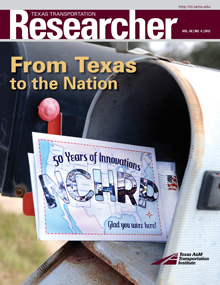Basing Informed Decisions on Reliable Research
Panama Canal Expansion

The expansion of the Panama Canal promises implications for global shipping patterns, including those influencing Texas ports. By any measure, those ports are critically important to the Texas economy, accounting for nearly 1.4 million jobs and more than $82 billion in personal income each year. The Texas Department of Transportation (TxDOT) formed the Panama Canal Working Group in 2012 and sponsored a research study conducted by TTI to assess opportunities associated with the canal expansion, particularly the potential impacts on ports and landside infrastructure, including roadways, railroads and intermodal facilities. TTI examined previous studies on the canal expansion and heard from shippers, ports, carriers, industry groups and other stakeholders at a series of meetings. The overarching finding from the study is that the Panama Canal expansion — coupled with continued population grown in Texas, energy-sector developments and the emergence of new trading partners throughout the world — represents opportunities to expand Texas’ position as a global gateway for the nation. By providing a low-cost, reliable, safe, secure, multimodal and environmentally sustainable supply chain, the state can increase its global trade, create new jobs, and expand the state and national economies.
Impact of the Energy Sector on Roadways

It’s hard to overstate the energy sector’s impact in Texas. The industry directly employs nearly 225,000 Texans in oil and gas exploration and production, accounting for almost 13 percent of all new jobs added in the state over the past year. The rapid growth of wind-power generation has further bolstered the energy sector’s contributions. But impacts can also be negative. Countless trucks carrying construction materials, heavy equipment, fracking water, petroleum products and other supplies strain roadways literally to the breaking point, necessitating extensive and expensive pavement repairs. Many truckloads are overweight, further exacerbating the problem. TTI researchers have worked with TxDOT to measure and project the impact of this wear and tear, which TxDOT estimates at roughly $2 billion per year for state and county road systems. TTI recommendations included donation agreements with energy companies, procedural changes related to early notification of development activity, and better coordination of road maintenance and repair.
Mobility Investment Priorities
Traffic congestion in Texas is choking our highways and economy. In our most congested cities, lost time and wasted fuel now cost us nearly $10 billion a year. However, this is not just a big-city issue. Stop-and-go traffic that slows down freight in our major cities will make small-town Texans pay more for groceries, clothes and countless other goods. Recognizing the growing urgency of this problem, the Texas Legislature set aside $300 million to get the state’s highest-priority roadway projects moving. TTI was assigned to help TxDOT and local agencies advance those projects with the most potential to improve mobility and strengthen local economies in the most congested regions of the state, as well as to help identify the most publicly acceptable options to pay for those projects. The Lone Star State’s population is growing, while transportation revenues are shrinking. TTI’s Mobility Investment Priorities project is assisting state leaders in closing that gap.
My 35 Expansion Project

In one of the most ambitious roadway improvement projects in the state’s history, TxDOT is expanding a 96-mile section of I-35 in Central Texas from four to six lanes. The effort is designed to alleviate traffic congestion that wastes both fuel and time for motorists, businesses and shippers. In addition, the expansion will help accommodate future increases in population, traffic volume and commercial activity as Texas continues to grow at a rapid pace. The collection of 17 separate but integrated construction projects will require $2.5 billion and five more years to complete. The massive effort also requires getting information — lots of information — to drivers and shippers planning trips and navigating lane closures and work zones characteristic of roadway expansions. To that end, TTI is providing TxDOT with a first-of-its-kind traveler information system that integrates three methods for capturing traffic data and forecasts congestion to provide that information to anyone who needs it.
Border Security and Mobility

For border-crossing users, time delays are inconvenient and costly. More accurate border wait times can help users plan additional travel times or adopt alternatives to reduce delays. Using radio frequency identification tags, researchers at TTI’s Center for International Intelligent Transportation Research in El Paso developed a website that combines delay performance measures with economic factors. Combining this information allows users to determine departure time and port-of-entry selection to help reduce delay costs. The website’s information also benefits policy makers by providing a way to track and analyze trends associated with delay costs at ports of entry.
Measuring the “Cost of Doing Nothing”
As Texas grows, demand for roadway space grows with it — even as available revenue and funding options become more limited. The cost of meeting future mobility needs is substantial, but the consequences of doing nothing to meet them are even greater. TTI calculated that expense in a number of ways, illustrating what life would be like in a state without transportation investment:
- Over the next 15 years, congestion would cost the state an average of $20 billion each year.
- Over the same time period, the delays experienced by commuters would double from 37 hours to 74 hours each year.
- The additional 37 hours of delay would cost each household another $800 annually, increasing with each passing year.
Conversely, for every dollar spent on transportation, the state realizes at least $6 in economic benefits.
